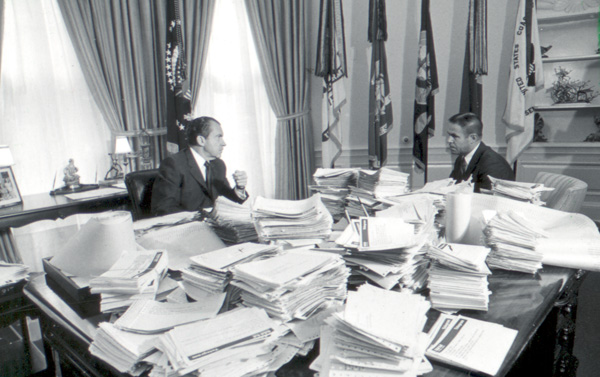President Nixon with chief-of-staff H.R. Haldeman the day after the president’s November 3, 1969 speech on the Vietnam War. The Oval Office desk was stacked with hundreds of telegrams and letters of support from the general public.
By Jason Schwartz
The Vietnam War elevated political and civil tension within the United States in ways not experienced since the Civil War. Mass demonstrations on city streets and college campuses became more frequent throughout the presidency of Lyndon B. Johnson, provoking frustrations which eventually influenced wartime policy and disqualifying himself from a second bid for the Oval Office. Giving ample consideration the surrounding discourse, President Richard Nixon was determined to establish decree and maintain a flexible approach in Vietnam unlike his predecessor. “It is becoming more obvious with every passing day,” the Washington Post reported on October 7, “that the men and the movement that broke Lyndon Johnson’s authority in 1968 are out to break Richard Nixon in 1969.” Both at home and abroad, the continuation of unrest demonstrated the need for a defining gesture to distinguish the current Vietnam approach from those applied in the past. Against the backdrop of a 15 October 1969 gathering of 250,000 person demonstration on Washington, Nixon began preparation for a previously announced statement concerning Vietnam scheduled for 3 November.
Determined to outline his desire for peace under terms that satisfied the interests of American geopolitical credibility and maintaining the sovereignty of South Vietnam, the President weighed each and every factor while constructing what would become the “Silent Majority” speech. Members of the White House staff, Cabinet members, and congressional leaders were all consulted. Unlike others that have occupied the Oval Office, Nixon took pride in the active role and continuous involvement throughout the writing process of his major presidential addresses. Taking a long weekend to Camp David, the President worked fourteen hour days in a continual pursuit of perfection – eventually totaling twelve drafts in all. “The baby’s just been born,” Nixon reported to his Chief of Staff Bob Haldeman during an early morning phone call immediately following its completion.
Many defining elements of the Nixon presidency emerged the 3 November 1969 address. Contesting what he believed to be a defiant vocal minority who dominated the Vietnam conversation, he called upon the “Silent Majority” to support staying the course until a favorable peace could be won. Dubbed a “political masterstroke” of language reinvention by Nixon biographer Evan Thomas, the phrase remains in contemporary political vernacular. Exceeding just rhetoric, concrete policy foundations were additionally put into place. Appeasing those concerned with the level of American military entanglement abroad, the President articulated a strategy to bolster regional forces through a process called “Vietnamization.” Through the supply of arms and training, the South Vietnamese could begin to rely on themselves for security in due time. Clarifying comments Nixon made at a 25 July press conference on the island of Guam, the initiative was part of shifting principles of foreign policy which became known as the “Nixon Doctrine.” Indeed, the United States would uphold responsibilities assured through treaties and alliances. Providing a nuclear shield and conventional weapons to deter communist aggression, the United States would no longer supply manpower to resolve local matters.
The public response was enormous. Flooded by tens of thousands of telegrams and letters, the White House struggled to keep pace with the level of incoming correspondence. Striking a nerve with the matter in which he addressed national unrest and the warm, Gallup polls tracked the President’s approval rate at an impressive 68 percent. Such popular support demonstrated a much needed mandate to carry out directives. Achieving its primary objective, Nixon had simultaneously wrestled directive control of the Vietnam War from the opposition and outlined his forward vision for the United States.
[scribd id=364002711 key=key-SdePJWxU8G6Jb52Tl5N5 mode=scroll]
[scribd id=364003054 key=key-EUxcgZhN5qpQ8O4hJzuw mode=scroll]

